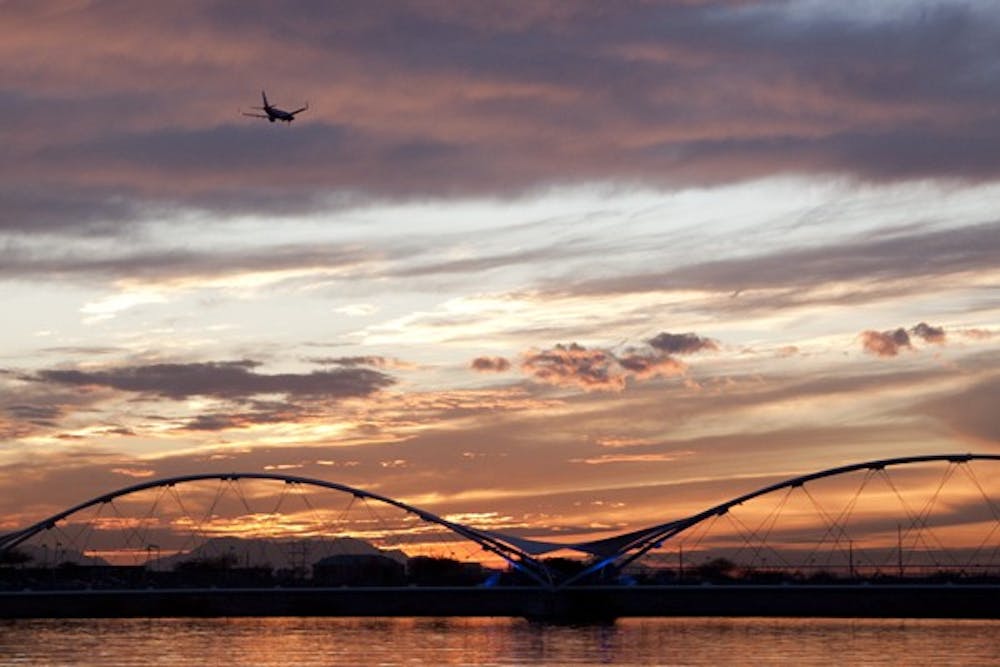 A plane flies over Tempe Town Lake towards Sky Harbor as the sun sets. The Tempe City Council has been dealing with noise complaints from air traffic. (Photo by Abhiram Chandrashekar)
A plane flies over Tempe Town Lake towards Sky Harbor as the sun sets. The Tempe City Council has been dealing with noise complaints from air traffic. (Photo by Abhiram Chandrashekar)
The Tempe Aviation Commission introduced a survey for Tempe residents in an attempt to understand and lessen aircraft noise.
Tempe is one of many cities that frequently survey their residents on noise pollution.
Barbara Sherman, vice chairwoman of the Tempe Aviation Commission, said these surveys allow the city to analyze where aircraft and other transportation noise seems to be greater.
“There tend to be significant problems in certain areas,” Sherman said. “The survey highlights different areas and gives us a sense of where noise occurs most often and who it creates most issues for.”
She said the survey has been an ongoing attempt to ask residents about traffic and aviation noise, and how it affects their daily lives in Tempe. The commission began a new survey in 2013 and has not yet decided when to close it.
“This is a new attempt to have a continuous survey to tap into what is happening in the city with the noise issues,” Sherman said.
She said the commission follows the pattern of previous noise pollution surveys conducted over the phone by Bruce Merrill, a retired ASU professor of the Walter Cronkite School of Journalism and Mass Communication. Merrill was hired by the city to conduct these questionnaires and give his findings to the council.
Sherman said the questions asked of residents today are similar to Merrill's questions, but have been slightly changed for the new online approach to the survey.
Questions range from how often residents are disturbed by noise to what forms of transportation in the Tempe area cause the most noise pollution.
She said the survey continues today because noise pollution has been an ongoing issue.
“Over time, there have been complaints about all sorts of things on the noise issue,” she said.
Sherman said the aviation commission was able to analyze the data and determine railroad noise was a major concern for Tempe residents after a previous city-wide survey.
She said the commission told the Tempe City Council the results and the commission's recommendations to lessen railroad noise throughout Tempe, including establishing Tempe as a "Quiet Zone" for trains.
“This was a major breakthrough in railroad noise," she said. "Now trains don't signal through Tempe anymore."
The council takes the commission's recommendations and applies them to city policies to improve the noise issues from traffic, busses, the light rail and airplanes.
Sherman said traffic has been an ongoing issue for years in Tempe, and the commission and council are still working on improvements to traffic noise pollution.
Aviation noise pollution overrides all other noise in most cases, she said.
“Traffic noise is a continuous problem in Tempe, but aviation noise is a continuous problem, too,” she said. “Aviation tends to be noisier.”
Commission member Alyson Star, 61, said the aviation noise and flight paths are constant battles in both Tempe and Phoenix.
“There is an ongoing controversy where planes are supposed to fly,” Star said. “More and more studies are coming out ... noise is affecting the health of students and residents.”
She said many people who do not hear the ongoing aviation noise do not understand what an important issue it is for cities like Tempe that are so close to major airports.
“People do complain about the noise and not being able to be in their yards ... not being able to have their windows open ... not being able to enjoy outdoor events,” Star said. “(The commission) allows them to get their voices heard anonymously, so we know where they are having issues.”
She said issues really began in 2000, when the Phoenix Sky Harbor International Airport announced its third runway. The third runway increased aviation noise dramatically, especially for residents who live in or near flight paths.
Councilwoman Shana Ellis said when she moved to Tempe, she knew she was living near a flight path from the original two runways. However, the third runway began disrupting residents who did not intend to live in a flight path.
“I feel bad for (those residents), because I know a lot of them bought their homes and then runways were added ... and so it got louder,” Ellis said. “I knew what I was getting into, and they didn't.”
Ellis said the council has worked with the commission and the city of Phoenix to alleviate aviation noise in Tempe. Although airplanes have improved over the years, noise is an ongoing issue for Tempe residents, she said.
“I'm sure (the new planes) are quieter than the ones from 30 years ago, but we still have a lot of 30-year-old planes in the air,” Ellis said.
The council plans to work with the commission when it receives a collaborative recommendation from the survey's data.
Ellis said the aviation noise can be worked with and managed reasonably today, but runways added in the future would be extremely problematic for Tempe.
“It will come to head if Phoenix ever announces they are going to build a fourth runway,” she said. “That will be a mess.”
Star said the commission will not begin to gather data to give the council recommendations until around May 2013, when the commission has collected enough responses.
Sherman said the commission works independently from questionnaires given from other transportation commissions and the Sky Harbor International Airport.
However, the council takes results from these other surveys into consideration when determining how to improve noise pollution in Tempe.
The survey is available on the city of Tempe website.
Reach the reporter at wpogden@asu.edu or follow her on Twitter @whitneyparis10




